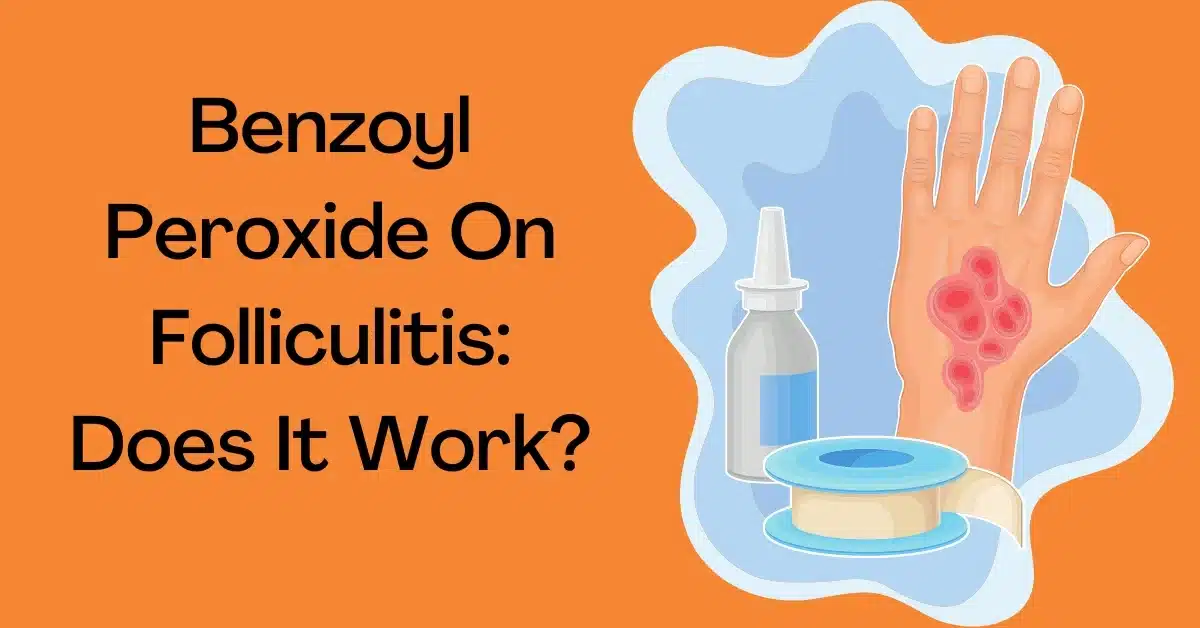Benzoyl Peroxide On Folliculitis: Does It Work?

Folliculitis is a prevalent skin condition that has the potential to cause discomfort and embarrassment. It occurs when hair follicles become inflamed due to various factors such as bacteria, fungi, or blockage. It commonly occurs in areas where hair follicles are more abundant, such as the scalp, face, neck, chest, back, vagina, and thighs.
If you’re dealing with folliculitis, you may have encountered benzoyl peroxide as a potential treatment option. We will explore the effectiveness of benzoyl peroxide for folliculitis and discuss its different forms, including benzoyl peroxide soap and cream. So, let’s dive in and find out if benzoyl peroxide is the right solution for your folliculitis concerns.
Table Of Contents
- Role of Benzoyl Peroxide in Treating Folliculitis
- The Science Behind Benzoyl Peroxide and How It Works on the Skin
- Benefits of Using Benzoyl Peroxide for Folliculitis Treatment
- Proper Application and Usage Guidelines for Benzoyl Peroxide
- Potential Side Effects and Precautions when Using Benzoyl Peroxide
- Comparing Benzoyl Peroxide with Other Folliculitis Treatment Options
- Recommendations for Choosing the Right Benzoyl Peroxide Product
- Other Benzoyl Peroxide Products
- Final Thoughts
Role Of Benzoyl Peroxide In Treating Folliculitis
Folliculitis is a prevalent skin condition characterized by the inflammation of hair follicles, resulting in red, swollen bumps on the skin. These bumps, often accompanied by itching or tenderness, can happen because of various factors, such as bacteria, fungi, or even certain irritants.
Benzoyl peroxide, a potent ingredient widely used in acne treatments, has proven to be highly effective in combating the bacteria responsible for folliculitis. Its ability to penetrate the follicles and kill the bacteria at the root is what sets it apart as a reliable treatment option.
Benzoyl peroxide functions by releasing oxygen into the skin’s pores, creating an oxygen-rich environment that is inhospitable to acne-causing bacteria. This, in turn, helps to reduce inflammation and prevent future breakouts. By targeting the bacteria directly, benzoyl peroxide not only treats existing folliculitis but also helps to prevent further infections.
It is important to note that benzoyl peroxide may not be suitable for all types of folliculitis. In cases where the condition is caused by factors other than bacteria, such as yeast or fungal infections, alternative treatment options may be more appropriate.
It is always advisable to consult a dermatologist to determine the underlying cause of your folliculitis and identify the most effective course of treatment.
The Science Behind Benzoyl Peroxide And How It Works On The Skin
To truly understand the power of benzoyl peroxide, we must delve into its scientific properties and how it interacts with the skin. Benzoyl peroxide is an organic compound that contains two oxygen atoms bonded together. When applied to the skin, it decomposes, releasing oxygen into the pores. This process is known as “oxygenation” and is the key to the antibacterial properties of benzoyl peroxide.
The release of oxygen creates an oxygen-rich environment within the pores, which is toxic to the bacteria that cause folliculitis. The bacteria, known as Propionibacterium acnes, thrive in an oxygen-deprived environment. By introducing oxygen, benzoyl peroxide effectively suffocates these bacteria, reducing inflammation and preventing further breakouts.
Apart from its antibacterial properties, benzoyl peroxide also acts as an exfoliant, helping to remove dead skin cells and unclog pores. This exfoliating action helps to prevent the buildup of sebum and debris, which can contribute to the development of folliculitis. By keeping the pores clear and free from blockages, benzoyl peroxide promotes healthier, clearer skin.
Benefits Of Using Benzoyl Peroxide For Folliculitis Treatment
The benefits of using benzoyl peroxide for folliculitis treatment are numerous and far-reaching. Not only does it effectively combat the bacteria responsible for the condition, but it also offers a range of additional advantages, making it a suitable option for individuals looking for relief from folliculitis.
One of the key benefits of benzoyl peroxide is its ability to penetrate the pores deeply. This allows it to reach the root of the problem, targeting the bacteria and reducing inflammation from within. Unlike other topical treatments that may only address the surface of the skin, benzoyl peroxide tackles the issue at its source, providing long-lasting relief.
Another advantage of benzoyl peroxide is its versatility. It can be used as a spot treatment for individual blemishes or as a preventative measure to ward off future breakouts. Its gentle yet effective nature makes it suitable for all skin types, including sensitive skin. This versatility ensures that anyone struggling with folliculitis can benefit from the healing properties of benzoyl peroxide.
Furthermore, benzoyl peroxide has been extensively studied and proven to be safe for long-term use. Unlike some other acne treatments that may cause dryness or irritation, benzoyl peroxide is generally well-tolerated and does not disrupt the skin’s natural moisture balance. This makes it a reliable and sustainable option for ongoing folliculitis management.
Proper Application And Usage Guidelines For Benzoyl Peroxide
To reap the full benefits of benzoyl peroxide, it is essential to follow proper application and usage guidelines. Here are some tips to help you make the most of this powerful ingredient:
#1 Start with cleansing
Before applying benzoyl peroxide, cleanse the affected area with a mild cleanser to get rid of any dirt, oil, or makeup. This will ensure that the product effectively reaches deep into the pores.
#2 Use a pea-sized amount
A little goes a long way with benzoyl peroxide. Start with a small amount, about the size of a pea, and apply it to the affected areas. Avoid applying it to unaffected areas of the skin to prevent unnecessary dryness or irritation.
#3 Gradually increase the frequency
If you’re new to using benzoyl peroxide, start by applying it once a day, preferably in the evening. Once your skin adapts to the product, you have the option to gradually increase the frequency to twice a day if necessary.
#4 Moisturize after application
Benzoyl peroxide has the potential to cause dryness to the skin, so it’s important to follow up with a moisturizer to keep your skin hydrated. Look for a lightweight, oil-free moisturizer that won’t clog your pores.
#5 Protect your skin from the sun
Benzoyl peroxide can increase your skin’s sensitivity to the sun, so it’s crucial to wear sunscreen with at least SPF 30 every day, even on cloudy days.
Remember, consistency is the key when using benzoyl peroxide. Stick to your skincare routine and give it time to work its magic. Results may not be immediate, but with patience and persistence, you will start to see improvements in your folliculitis.
Potential Side Effects And Precautions When Using Benzoyl Peroxide
While benzoyl peroxide is generally safe and well-tolerated, it can lead to certain side effects, particularly when used incorrectly or in high concentrations. It’s important to be aware of these potential side effects and take the necessary precautions to minimize any risks.
One of the most common side effects of benzoyl peroxide is dryness and peeling of the skin. This can be particularly noticeable during the initial stages of treatment when your skin is still adjusting. To mitigate this, start with a lower concentration of benzoyl peroxide, usually 2.5% or 5%, and gradually increase if needed. Also, be sure to moisturize your skin regularly to keep it hydrated.
Another possible side effect is redness and irritation. If you experience any excessive redness, itching, or burning, discontinue use and consult a dermatologist. They can provide guidance on adjusting your skincare routine or recommend alternative treatment options.
It is important to be aware that benzoyl peroxide has the potential to bleach fabrics. Therefore, be cautious to prevent any contact with towels, clothing, or bedding. Use white or old towels when drying your face, and allow the product to absorb fully into the skin before coming into contact with textiles.
Lastly, if you’re pregnant or breastfeeding, it’s always best to consult with your healthcare provider before using benzoyl peroxide or any other skincare product. While there is limited research on the effects of benzoyl peroxide during pregnancy or breastfeeding, it’s important to err on the side of caution and seek professional advice.
Comparing Benzoyl Peroxide With Other Folliculitis Treatment Options
Benzoyl peroxide is not the only treatment option available for folliculitis. There are several other alternatives that may be suitable depending on the underlying cause and severity of your condition. Let’s take a closer look at some of these options and compare them to benzoyl peroxide.
1. Topical Antibiotics
Topical antibiotics, such as erythromycin or clindamycin, are commonly prescribed for bacterial folliculitis. While they can be effective in treating the condition, they may also carry a higher risk of developing antibiotic resistance over time.
2. Retinoids
Retinoids, such as tretinoin or adapalene, are another class of medications used to treat folliculitis. They work by stimulating cell renewal and inhibiting the clogging of hair follicles. Retinoids can be effective, but they may cause dryness and increased sensitivity to sunlight.
3. Tea Tree Oil
Tea tree oil is a traditional natural remedy that has been utilized for centuries to address various skin conditions, including folliculitis. It possesses antimicrobial properties and can help reduce inflammation. However, it may not be as potent as benzoyl peroxide in combating bacteria.
4. Oral Antibiotics
In severe cases of folliculitis, oral antibiotics may be prescribed to address the underlying infection. These medications are typically reserved for more persistent or widespread cases and should be used under medical supervision.
When considering these treatment options, it’s important to consult a dermatologist who can assess your individual condition and recommend the most appropriate course of action. They will take into account factors such as the severity of your folliculitis, your medical history, and any potential contraindications to determine the best treatment approach for you.
Recommendations For Choosing The Right Benzoyl Peroxide Product
When it comes to choosing a benzoyl peroxide product, it is crucial to take into account several essential factors to ensure you find the right one for your needs. Here are some recommendations to guide you in selecting the best benzoyl peroxide product:
1. Concentration
Benzoyl peroxide is available in different concentrations, ranging from 2.5% to 10%. It’s generally recommended to start with a lower concentration, such as 2.5% or 5%, and gradually increase if needed.
Higher concentrations may be more effective in severe cases, but they can also be more drying and potentially irritating to the skin.
2. Formulation
Benzoyl peroxide comes in various formulations, including gels, creams, lotions, and cleansers. Consider your skin type and preferences when choosing a formulation.
For oily or acne-prone skin, a gel or lotion may be more suitable, while those with dry or sensitive skin may prefer a cream or cleanser.
3. Non-Comedogenic
Look for benzoyl peroxide products that are labeled as non-comedogenic. This means they are formulated to not clog pores, reducing the risk of further breakouts.
4. Additional Ingredients
Some benzoyl peroxide products may contain additional ingredients, such as moisturizers or soothing agents, to mitigate potential dryness or irritation. These can be beneficial, especially for those with sensitive skin.
5. Brand Reputation
Research the brand’s reputation and read customer reviews to ensure you’re choosing a trusted and reliable product. Look for brands that prioritize quality and have a track record of producing effective skincare solutions.
Remember, what works for one person may not work for another, so it may take some trial and error to find the perfect benzoyl peroxide product for you. Be patient and persistent in your search, and don’t hesitate to seek professional advice if needed.
Other Benzoyl Peroxide Products
Benzoyl peroxide soap can be an effective option for treating folliculitis, especially when the condition is mild. It is essential to cleanse the affected area gently with benzoyl peroxide soap and warm water, ensuring that the soap lathers well. This helps to remove excess oil, dead skin cells, and bacteria, reducing the risk of further infection and promoting healing.
Benzoyl peroxide wash is another option for treating folliculitis. It is typically used in the shower or bath and is left on the skin for a few minutes before rinsing off. Benzoyl peroxide wash can be especially beneficial for larger areas affected by folliculitis, such as the back or chest.
Final Thoughts
Benzoyl peroxide has demonstrated its effectiveness in treating folliculitis by targeting the underlying bacteria and reducing inflammation. It provides various advantages, such as being readily available, cost-effective, and user-friendly.
However, individual experiences may vary, and some may require alternative or combination therapies. It is crucial to seek advice from a healthcare professional or dermatologist to assess the suitability of benzoyl peroxide for your specific case of folliculitis.
By following proper usage guidelines, monitoring for potential side effects, and considering other treatment options, you can make informed decisions to manage and improve your folliculitis condition effectively.
FAQs
Q: Is benzoyl peroxide safe to use on sensitive skin?
A: Benzoyl peroxide can be used on sensitive skin, but it is recommended to start with a low concentration and monitor the skin’s reaction. If you encounter any irritation, discontinue product usage and seek professional advice.
Q: Can benzoyl peroxide be used on the scalp for folliculitis?
A: Yes, benzoyl peroxide can be used on the scalp for folliculitis. However, it is advisable to consult with a dermatologist for proper guidance and recommendations.
Q: Can benzoyl peroxide be used for the long-term treatment of folliculitis?
A: Long-term use of benzoyl peroxide for folliculitis should be done under the supervision of a healthcare professional. They can assess the condition and determine the most suitable long-term treatment plan.
Q: Are there any natural remedies for folliculitis?
A: Some natural remedies – tea tree oil or apple cider vinegar – may have antimicrobial properties that can help with folliculitis. However, their effectiveness may vary, and it is advisable to consult a dermatologist before incorporating them into your routine.
Q: Can benzoyl peroxide be used to prevent future episodes of folliculitis?
A: Benzoyl peroxide can be used as a preventive measure for folliculitis. Regular use of benzoyl peroxide cleansers or washes in susceptible areas can help reduce the risk of future episodes.
References
https://emedicine.medscape.com/article/1070456-treatment?icd=login_success_email_match_norm#showall





